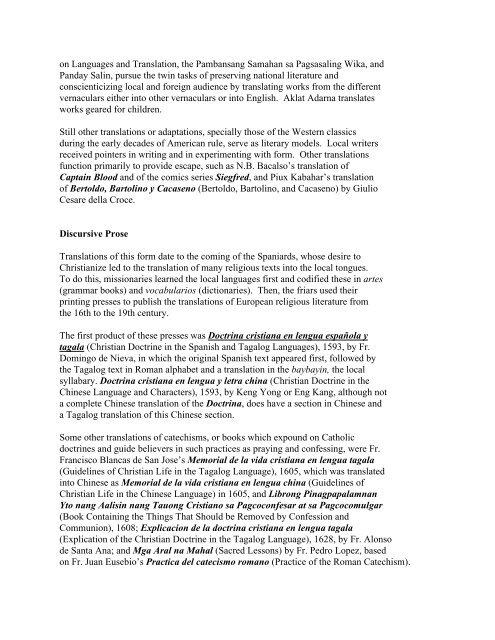TRANSLATION AND ADAPTATION Translation is the rendition of a ...
TRANSLATION AND ADAPTATION Translation is the rendition of a ...
TRANSLATION AND ADAPTATION Translation is the rendition of a ...
Create successful ePaper yourself
Turn your PDF publications into a flip-book with our unique Google optimized e-Paper software.
on Languages and <strong>Translation</strong>, <strong>the</strong> Pambansang Samahan sa Pagsasaling Wika, and<br />
Panday Salin, pursue <strong>the</strong> twin tasks <strong>of</strong> preserving national literature and<br />
conscienticizing local and foreign audience by translating works from <strong>the</strong> different<br />
vernaculars ei<strong>the</strong>r into o<strong>the</strong>r vernaculars or into Engl<strong>is</strong>h. Aklat Adarna translates<br />
works geared for children.<br />
Still o<strong>the</strong>r translations or adaptations, specially those <strong>of</strong> <strong>the</strong> Western classics<br />
during <strong>the</strong> early decades <strong>of</strong> American rule, serve as literary models. Local writers<br />
received pointers in writing and in experimenting with form. O<strong>the</strong>r translations<br />
function primarily to provide escape, such as N.B. Bacalso’s translation <strong>of</strong><br />
Captain Blood and <strong>of</strong> <strong>the</strong> comics series Siegfred, and Piux Kabahar’s translation<br />
<strong>of</strong> Bertoldo, Bartolino y Cacaseno (Bertoldo, Bartolino, and Cacaseno) by Giulio<br />
Cesare della Croce.<br />
D<strong>is</strong>cursive Prose<br />
<strong>Translation</strong>s <strong>of</strong> th<strong>is</strong> form date to <strong>the</strong> coming <strong>of</strong> <strong>the</strong> Spaniards, whose desire to<br />
Chr<strong>is</strong>tianize led to <strong>the</strong> translation <strong>of</strong> many religious texts into <strong>the</strong> local tongues.<br />
To do th<strong>is</strong>, m<strong>is</strong>sionaries learned <strong>the</strong> local languages first and codified <strong>the</strong>se in artes<br />
(grammar books) and vocabularios (dictionaries). Then, <strong>the</strong> friars used <strong>the</strong>ir<br />
printing presses to publ<strong>is</strong>h <strong>the</strong> translations <strong>of</strong> European religious literature from<br />
<strong>the</strong> 16th to <strong>the</strong> 19th century.<br />
The first product <strong>of</strong> <strong>the</strong>se presses was Doctrina cr<strong>is</strong>tiana en lengua española y<br />
tagala (Chr<strong>is</strong>tian Doctrine in <strong>the</strong> Span<strong>is</strong>h and Tagalog Languages), 1593, by Fr.<br />
Domingo de Nieva, in which <strong>the</strong> original Span<strong>is</strong>h text appeared first, followed by<br />
<strong>the</strong> Tagalog text in Roman alphabet and a translation in <strong>the</strong> baybayin, <strong>the</strong> local<br />
syllabary. Doctrina cr<strong>is</strong>tiana en lengua y letra china (Chr<strong>is</strong>tian Doctrine in <strong>the</strong><br />
Chinese Language and Characters), 1593, by Keng Yong or Eng Kang, although not<br />
a complete Chinese translation <strong>of</strong> <strong>the</strong> Doctrina, does have a section in Chinese and<br />
a Tagalog translation <strong>of</strong> th<strong>is</strong> Chinese section.<br />
Some o<strong>the</strong>r translations <strong>of</strong> catech<strong>is</strong>ms, or books which expound on Catholic<br />
doctrines and guide believers in such practices as praying and confessing, were Fr.<br />
Franc<strong>is</strong>co Blancas de San Jose’s Memorial de la vida cr<strong>is</strong>tiana en lengua tagala<br />
(Guidelines <strong>of</strong> Chr<strong>is</strong>tian Life in <strong>the</strong> Tagalog Language), 1605, which was translated<br />
into Chinese as Memorial de la vida cr<strong>is</strong>tiana en lengua china (Guidelines <strong>of</strong><br />
Chr<strong>is</strong>tian Life in <strong>the</strong> Chinese Language) in 1605, and Librong Pinagpapalamnan<br />
Yto nang Aal<strong>is</strong>in nang Tauong Cr<strong>is</strong>tiano sa Pagcoconfesar at sa Pagcocomulgar<br />
(Book Containing <strong>the</strong> Things That Should be Removed by Confession and<br />
Communion), 1608; Explicacion de la doctrina cr<strong>is</strong>tiana en lengua tagala<br />
(Explication <strong>of</strong> <strong>the</strong> Chr<strong>is</strong>tian Doctrine in <strong>the</strong> Tagalog Language), 1628, by Fr. Alonso<br />
de Santa Ana; and Mga Aral na Mahal (Sacred Lessons) by Fr. Pedro Lopez, based<br />
on Fr. Juan Eusebio’s Practica del catec<strong>is</strong>mo romano (Practice <strong>of</strong> <strong>the</strong> Roman Catech<strong>is</strong>m).
















